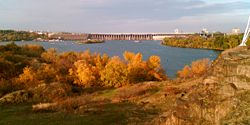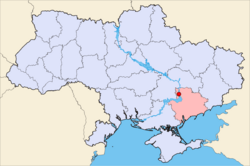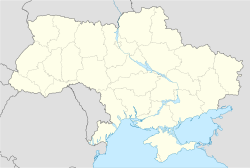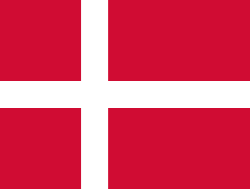Zaporizhia
| Zaporizhzhia Запоріжжя |
|||
 |
|||
|
|||
 |
|||
 Zaporizhzhia
|
|||
| Coordinates: | |||
| Country Oblast Raion |
Ukraine Zaporizhia Oblast Zaporizhia City Municipality |
||
|---|---|---|---|
| Founded | 1770 | ||
| Government | |||
| - Mayor | Yevhen Kartashov | ||
| Area | |||
| - Total | 358 km² (138.2 sq mi) | ||
| Elevation | 86 m (282 ft) | ||
| Population (2007)[1] | |||
| - Total | 790,000 | ||
| - Density | 2,253/km² (5,835.2/sq mi) | ||
| Postal code | 69000- | ||
| Area code(s) | +380 61 | ||
| Website: www.meria.zp.ua | |||
Zaporizhia, also referred to as Zaporozhye (Ukrainian: Запоріжжя, translit. Zaporizhzhia, Russian: Запорожье, translit. Zaporozh'ye, Polish: Zaporoże) is a city in south-central Ukraine, which rests on the banks of the Dnieper River. It is the administrative center of the Zaporizhia Oblast (province), as well as the administrative center of the surrounding Zaporizkyi Raion (district) within the oblast. The city itself is directly subordinate to the oblast, and is located approximately 70 km (43 mi) from the city of Dnipropetrovsk.
Zaporizhia was formerly referred to as Aleksandrovsk (Russian: Александровск), after the commander of the first Russian Army, Prince Alexander Golitsyn, but was renamed in 1921 to Zaporizhia (literally, "behind the cataracts", referring to the Dnieper cataracts near Khortytsia). It is currently the sixth largest city in Ukraine and has a current estimated population of 790,000 (as of 2007).
Zaporizhia is an important industrial center of Ukraine, particularly a home for:
- famous hydroelectric power plant known as "DnieproGES";
- ZAZ, the country's main car manufacturing company;
- Motor-Sich design-bureau and production company, the world-famous aircraft engine manufacturer.
The city was very much an 'engineering city' during Soviet times, with all the consequences in terms of pollution that might be expected. The move to market economy since the independence of Ukraine has seen the demise of some of these concerns. This has improved the air quality. Although Zaporizhia is not regarded as a particularly attractive city, Dnieper River cruise ships make it one of their scheduled stops in order to visit Khortytsia Island.
Contents |
History
Archaeological finds in the area suggest that Scythian nomads were living here about 2 to 3 thousand years ago. In XV-XVII centuries this place was famous of the cossacs' fortress Zaporizka Sich. In 1770, Russian government established new fortress at the Dnieper River, named Aleksandrovsk. Until the beginning of the 20th century Aleksandrovsk was a small town. The city was named Aleksandrovsk until 1921 when the city's name was changed to Zaporizhia. During and after the World War II years, the city was the location of prisoner-of-war camps.

The city's Khortytsia Island which faces modern Zaporizhia across the Dnieper River, was one of the historic locations for the Zaporizhian Sich - the main fortress capital of the Cossack state (the Zaporozhian Host) and the Cossack Hetmanate republic.
In 1789 Mennonites from Prussia accepted an invitation from Catherine II of Russia and settled in what became the Chortitza Colony, northwest of Khortytsia island. Mennonite-owned mills and factories were built in Alexandrovsk and later appropriated by the Communist government. After the Russian Revolution many Mennonites immigrated, fled as refugees, or were deported from the area. Currently few Mennonites live in Zaporizhia. Mennonite buildings still exist in the area and in the other main Mennonite colony center, current day Molochansk.[2]
Economy and transport
Industry
After the end of the Russian Revolution, the city became an important industrial center. The presence of cheap labor and the proximity of deposits of coal, iron ore, and manganese created favorable conditions for large-scale enterprises of the iron and mechanical engineering industry. Today Zaporizhia is an important industrial centre of the region with heavy industry (particularly metallurgy), aluminium, and chemical industry. In the city cars, avia motors, radioelectronics are manufactured. The port of Zaporizhia is an important place of transshipment for goods from the Donbass. Zaporizhstal, Ukraine's fourth largest steel maker, ranks 54th in the world and is based in the city.
Electricity generation
Zaporizhia also has a big electricity generating complex fueled by industrial demand. The biggest nuclear power plant in Europe, the Zaporizhzhia Nuclear Power Plant, as well as the Dnieper Hydroelectric Station are located near the city, in addition to fossil fuel power plants.
Transport
Public transport is provided by buses, minibuses, tramway, river transport, and railway. The city has two railway stations, Zaporizhia #1 and #2. Zaporizhia #1 is the central station and located in the southern part of the city. It is easily accessible by taxi and minibus. Located along the Simferopol-Moscow transit route, there is convenient ground transportation to the north and south of Zaporizhia.
The city's sole airport operates both domestic and international flights. The neighbouring city of Dnipropetrovsk also has an airport with more frequent international flight service.
Sister cities
Zaporizhia is currently twinned with:
 Linz, Austria, since 1983
Linz, Austria, since 1983 Oberhausen, Germany, since 1986
Oberhausen, Germany, since 1986 Belfort, France
Belfort, France Lahti, Finland
Lahti, Finland Randers, Denmark
Randers, Denmark Magdeburg, Germany, since 2008
Magdeburg, Germany, since 2008
Footnotes
- ↑ Офіційний портал Запорізької міської влади | Головна
- ↑ Friesen, R. Building on the Past: Mennonite Architecture, Landscape and Settlements in Russia/Ukraine. Raduga Publications, 2004.
External links
- www.zabor.zp.ua - Zaporozhia. City portal (Ukrainian)
- www.misto.zp.ua - Zaporizhia. City portal (Ukrainian)
- Zaporozhia open forum
- meria.zp.ua - Zaporizhia City Administration website (Ukrainian)
- ukrtelecom.ua - Ukrtelecom webcam in Zaporizhia (English)
- Zaporizhia telephone directory
|
||||||||||||||||||||
|
|||||||||||||||||
